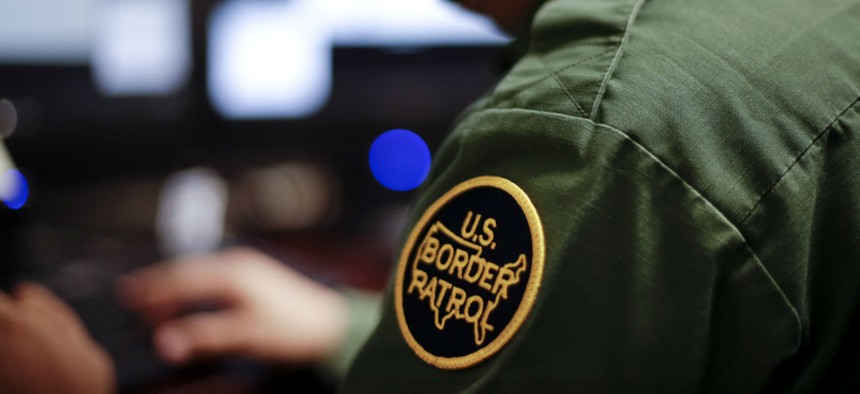DHS Switches on Retooled Virtual Fence Along Arizona Border

In this June 5, 2014 photo, a Border Patrol agent uses a headset and computer to conduct a long distance interview by video with a person arrested crossing the border in Texas, from a facility in San Diego. AP File Photo/Gregory Bull
Border Patrol has been watching videos of potentially suspicious activity from sensor-studded towers for two weeks.
While GOP presidential contenders broach novel ideas for U.S. border control, the Department of Homeland Security over the past couple of weeks has quietly resurrected an overhauled, 10-year-old virtual fence concept.
Video surveillance feeds from a handful of remote "integrated fixed towers" in southern Arizona are now on the computer screens of local Border Patrol personnel, DHS officials told reporters Monday. Officers just finished a second week of evaluating the monitoring system in Nogales, Arizona.
The digital wall replaces the $1 billion so-called Secure Border Initiative Network, conceived in 2005, which would have blanketed the entire southwest border with radar-equipped, camera-mounted towers. DHS abandoned the program in 2011, after realizing contract specifications did not jive with the reality of the harsh southwest terrain. Cameras malfunctioned and radars in densely populated areas proved futile.
Now, DHS officials say they are slowly installing sensor-studded turrets in pockets of Arizona only where it makes sense. Homeland Security has about $145 million to spend on up to six sets of pillars in the state. The aim of the border surveillance system is to spot and help responders stamp out illicit activity, such as human trafficking and drug smuggling.
For the past two weeks, Border Patrol personnel have been checking out the comfort and accuracy of the system, according to DHS.
"Annoying" factors like cameras that skip or computer controls that freeze are the types of issues officers are looking for, officials said. Also, they need to make sure the sensors are detecting all objects in the vicinity like, for instance, clothes and water bottles lying around. The Border Patrol has the final say-so on whether the government should take ownership of the system from developer Elbit Systems of America.
The company, a subsidiary of Elbit Systems, Israel's largest publicly traded defense firm, won the Arizona tower contract in 2014. A DHS official Monday acknowledged the company’s experience constructing sensor technology for a wall in the Palestinian West Bank factored into the decision to sign with Elbit. Also, the company's proposal was 75 percent of the estimated expected costs, the official said.
Elbit is now expanding into cyberspace, having recently clinched contracts with a national police agency in Europe and an African law enforcement agency to intercept communications, UPI reported Monday.
The company allegedly helped Israel successfully test a classified tunnel-detection system designed to stunt cross-border attacks by Palestinian militants, according to an April Newsweek article.
The first series of pillars in Arizona, costing $23 million, have been built and tested, DHS officials said. Along with video cameras, the towers are supplemented by an array of surveillance gear, including cameras on trucks and ground sensors.
The timeline for completion of the towers will be determined by future funding, officials said.
One day, the structures might also be deployed in certain areas of New Mexico and a very limited number of places outside the two states, where the environment can support radars and where there is illegal activity going on, officials said.
According to contracting documents, the system should be able to automatically flag and track humans traveling on foot, atop an animal or in a moving vehicle.
Some White House hopefuls have tossed out more revolutionary solutions to the problem of incursions along U.S. borders. The debate over how to deal with the country's 12 million undocumented immigrants and future border trespassers has taken center stage in the 2016 presidential campaign.
On Sunday, Republican candidate Scott Walker said erecting a wall along the northern border with Canada is worth considering. That proposal came the day after New Jersey Gov. Chris Christie suggested a tracking system modeled after the way FedEx keeps tabs on shipments.
Backtracking a bit on ”Fox News Sunday,” he said, “I don’t mean people are packages, so let’s not be ridiculous, but this is "a situation where the private sector laps us in the government with the use of technology. We should bring in the folks from FedEx to use the technology to be able to do it.”



